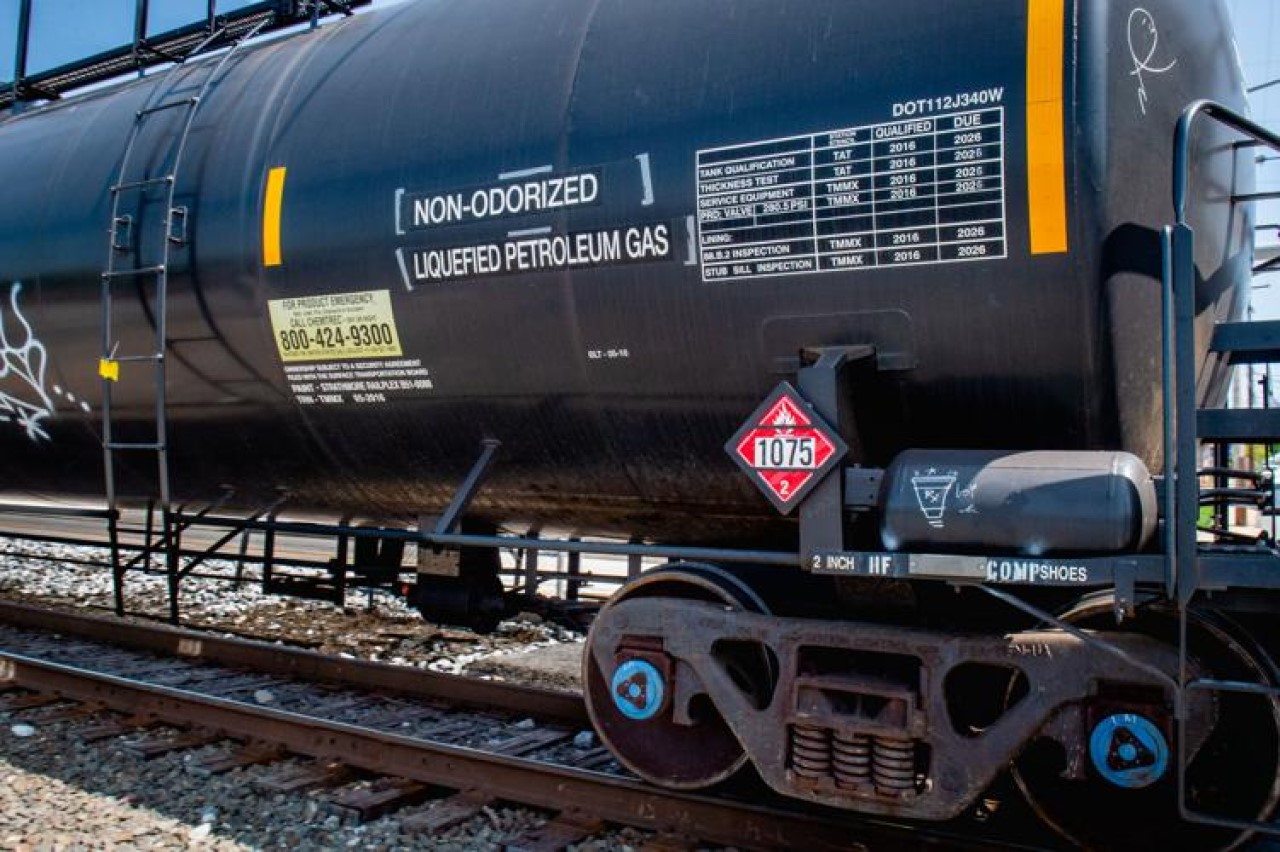
A railroad car labeled and placarded to be carrying liquified petroleum gas, moves on the railroad line along Front Street in Columbia Borough Wednesday, May 10, 2023.
Blaine Shahan / LNP | LancasterOnline

A railroad car labeled and placarded to be carrying liquified petroleum gas, moves on the railroad line along Front Street in Columbia Borough Wednesday, May 10, 2023.
Blaine Shahan / LNP | LancasterOnline

Blaine Shahan / LNP | LancasterOnline
A railroad car labeled and placarded to be carrying liquified petroleum gas, moves on the railroad line along Front Street in Columbia Borough Wednesday, May 10, 2023.
The Hazardous Rail Transit Plan for Lancaster County, provided by county officials through a right-to-know request, addresses railroad transportation risks and gives emergency responders a general response plan.
The plan, which is distributed to first responders and local emergency managers, outlines when to take action, how to identify hazardous material placards on a variety of railcar types, the procedures for emergency notification, how to establish incident command and organization, and information on how to inform other county, state and federal authorities.
The HART plan includes details on the railroads that operate in Lancaster County, areas for potential ecological risk and how to establish a disaster declaration.
The plan delineates responsibilities and protective equipment needed for fire departments, government officials, railroads and emergency management officials.
Here are highlights of the plan, which was redacted by county officials to protect “sensitive municipal and transportation routing information” and confidential information for the railroads.
We sought railroad hazmat records from 12 central Pa. counties; only 3 provided detailed lists
Hazardous material on Pa. trains: How we got the information
Toxic trains: Real-time hazmat info hard to get, even for Lancaster County’s first responders
At least 28 hazardous materials moved through Lancaster County in 2021
In an emergency on a rail line, first responders take into account several potential response actions, depending on the specific emergency.
The responses are classified as “offensive” for quick emergency control and aggressive action; “defensive” for confining the situation with action from a distance to keep the responders safe; or “non-intervention,” in which no action is taken due to high risk for responders or where action could make a situation worse.
Duane Hagelgans, emergency management coordinator for Millersville and Manor Township, provided examples of the response situations. Hagelgans is also the fire commissioner for Blue Rock Fire Rescue and a professor of emergency management at Millersville University.
An example would be crews going toward a leaking tanker to shut off a valve and stop a leak.
Defensive
An example would be a large fire in which crews set up ladder trucks and lines that flow large amounts of water and are not held by responders.
An example would be a situation with unknown chemicals or chemicals that are water-reactive; applying water to a large fire with burning oil would create runoff of contaminated water, possibly to nearby waterways or groundwater.
“Evacuation is sometimes, but not always, necessary,” according to the HART plan, which says the following criteria should be considered:
The mayor or senior township supervisor in an impacted municipality would direct any evacuation/sheltering-in-place measures.
The county commissioners can order an evacuation if the disaster emergency impacts several towns or if the municipal leaders fail to order those measures, can’t be located or are unable to properly communicate and coordinate those measures.
After a 911 call is received, Lancaster County-Wide Communications dispatchers will notify the following departments, in order:
The emergency management duty officer will then notify, in order:
Amtrak: Christiana, East Hempfield Township, East Lampeter Township, Elizabethtown, Lancaster city, Leacock Township, Manheim Township, Mount Joy, Mount Joy Township, Paradise Township, Rapho Township, Sadsbury Township, Salisbury Township, West Donegal Township, West Hempfield Township
Columbia & Reading: Columbia, West Hempfield Township
East Penn Railroad: Denver, East Cocalico Township, Ephrata Township, West Cocalico Township
Elizabethtown Industrial Railroad: West Donegal Township
Landisville Railroad: East Hempfield
Norfolk Southern: Columbia, Conestoga Township, Conoy Township, Drumore Township, Earl Township, East Donegal Township, East Earl Township, East Hempfield Township, East Lampeter Township, East Petersburg, Fulton Township, Lancaster city, Leacock Township, Lititz, Manheim, Manheim Township, Manor Township, Marietta, Martic Township, Mountville, New Holland, Penn Township, Upper Leacock Township, Warwick Township, West Hempfield Township
Strasburg Rail Road: Paradise Township, Strasburg Township
SOURCE: Hazardous Rail Transit Plan (HART) for Lancaster County
Norfolk Southern Port Road, which runs along the Susquehanna River, is the largest “through” freight route that does not start or stop in the county. The county’s Hazardous Rail Transit Plan identifies some nature preserves that could need to be evacuated or examined for toxic impact in the case of a derailment. The plan, though, points out that this is not an exhaustive list and does not include river islands.
Conestoga Township:
Sherry Ferry Wildflower Preserve
Conoy Township
Falmouth Access Park
Drumore Township
Ferncliff Wildflower Preserve
Fishing Creek Nature Preserve
Muddy Run Recreation Park
Susquehannock State Park
East Donegal Township
Riverfront Park
Manor Township
Observation Road and Recreation Area
Safe Harbor Nature Preserve
Turkey Hill Nature Preserve
Martic Township
House Rock Nature Preserve
Kelly’s Run Nature Area
Pinnacle Overlook
Reed Run Nature Preserve
Tucquan Glen Nature Preserve
West Hempfield Township
Chickies Rock County Park
SOURCE: Hazardous Rail Transit Plan (HART) for Lancaster County

A collection of interviews, photos, and music videos, featuring local musicians who have stopped by the WITF performance studio to share a little discussion and sound. Produced by WITF’s Joe Ulrich.
The days of journalism’s one-way street of simply producing stories for the public have long been over. Now, it’s time to find better ways to interact with you and ensure we meet your high standards of what a credible media organization should be.